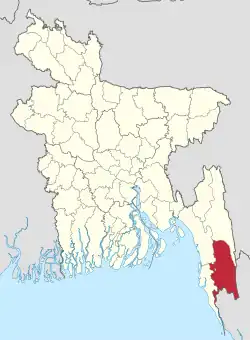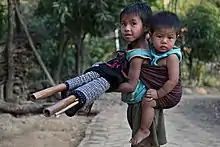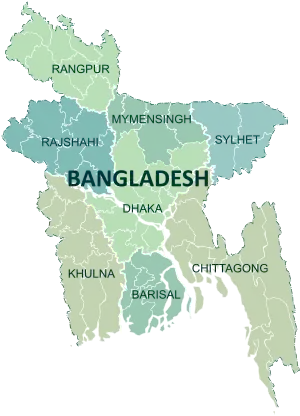Bandarban District
Bandarban (Bengali: বান্দরবান, Chakma: 𑄝𑄚𑄴𑄘𑄧𑄢𑄴𑄝𑄚𑄴) is a district in South-Eastern Bangladesh, and a part of the Chittagong Division.[5] It is one of the three hill districts of Bangladesh and a part of the Chittagong Hill Tracts, the others being Rangamati District and Khagrachhari District. Bandarban district (4,479 km2) is not only the most remote district of the country, but also the least populous (population 388,000).[6] There is an army contingent at Bandarban Cantonment.
Bandarban
বান্দরবান | |
|---|---|
.jpg.webp) .jpg.webp)    Clockwise from top-left: Nilachol, Jadipai waterfall, Keokradong, Buddha Dhatu Zadi, Boga lake | |
 Location of Bandarban in Bangladesh | |
Expandable map of Bandarban District | |
| Coordinates: 21°48′N 92°24′E | |
| Country | |
| Division | Chittagong Division |
| As a District | 18 April 1981 |
| Government | |
| • MP | Bir Bahadur Ushwe Sing (Awami League) |
| • Deputy Commissioner | Yasmin Parvin Tibriji[1] |
| • District Council Chairman | Kya Show Hla[2] |
| • Chief Executive Officer | A. T. M. Kawser Hossain[2] |
| Area | |
| • Total | 4,479.01 km2 (1,729.36 sq mi) |
| Population (2022 census)[3] | |
| • Total | 481,109 |
| • Density | 110/km2 (280/sq mi) |
| Time zone | UTC+06:00 (BST) |
| HDI (2019) | 0.574[4] medium · 19th of 20 |
| Website | bandarban |
Demographics
| Year | Pop. | ±% p.a. |
|---|---|---|
| 1974 | 116,426 | — |
| 1981 | 171,478 | +5.69% |
| 1991 | 230,569 | +3.01% |
| 2001 | 298,120 | +2.60% |
| 2011 | 388,335 | +2.68% |
| 2022 | 481,109 | +1.97% |
| Sources:[3][7] | ||
According to the 2022 Census of Bangladesh, Bandarban District had 106,167 households and a population of 481,109, 40.4% of whom lived in urban areas. The population density was 107 people per km2. The literacy rate (age 7 and over) was 63.4%, compared to the national average of 74.7%.[3]

As per the 2011 census, there were 215,934 Bengalis and 142,401 (36.67%) indigenous people in the district.[8] There are more than fifteen ethnic minorities living in the district besides the Bengalis, including: Marma, who are Arakanese descendants or Rakhine and are also known as Magh, Mru (also known as Mro or Murong), Bawm, Khyang, Tripura (also known as Tipra or Tipperah), Lushei (also known as Lushei), Khumi, Chak, Kuki, Chakma and Tanchangya (also spelt as Tenchungya).

The Mru, also known as Murong, who are famous for their music and dance. The Mru in major numbers have converted to the youngest religion in Bangladesh – Khrama (or Crama) – a religion that prohibits much of their old ways. They are proposed as the original inhabitants of Bandarban.[9][10]
Religious composition
| Religion | Population (1941)[11]: 104–105 | Percentage (1941) | Population (2011)[12] | Percentage (2023) |
|---|---|---|---|---|
| Tribal[lower-alpha 2] |
57,793 | 94.50% | 15,726 | 4.05% |
| Islam |
2,595 | 4.24% | 197,087 | 50.75% |
| Hinduism |
369 | 0.60% | 13,137 | 3.38% |
| Christianity |
0 | 0.00% | 39,333 | 10.13% |
| Buddhism |
--- | --- | 123,052 | 31.69% |
| Others [lower-alpha 3] | 399 | 0.65% | 0 | 0.00% |
| Total Population | 61,156 | 100% | 338,335 | 100% |
| Religion | 1991 | 2001 | 2011 | Perc 2011 | PGR 91-11 |
| Muslim | 109,800 | 147,062 | 197,087 | 50.8% | 79.5% |
| Hindu | 8,105 | 10,796 | 13,137 | 3.4% | 62.1% |
| Christian | 16,769 | 28,546 | 39,333 | 10.1% | 134.6% |
| Buddhist | 87,613 | 103,997 | 123,052 | 31.7% | 40.4% |
| Others | 8,282 | 7,719 | 15,726 | 4.0% | 89.9% |
| Total | 230,569 | 298,120 | 388,335 | 100.0% | 68.4% |
The religious composition of the population in 2011 was 50.75% Muslim, 31.69% Buddhist, 10.13% Christian, 3.38% Hindu and 4.05% others.[13] Religious institutions is Mosque 2,070, Buddhist 900 (256 temples, 644 pagodas), Hindu temple 94 and Church 2.[14]
Tourism
The India - Myanmar Sabroom - Cox's Bazar railway link has been proposed to connect Sabroom - Khargachari - Rangamati - Bandarban - Satkania - Cox's Bazar and another rail link connecting Bandarban to Tuipang, India.
Bandarban lies, by bus, eight hours away from Dhaka, two hours from Chittagong and three hours from Cox's Bazar. It is also possible to get there by a six-hour bus ride from Rangamati. The Buddha Dhatu Jadi, the Buddhist temple in Bangladesh, located in Balaghata, 4 km from the town. This place attracts many tourists every year. This Theravada Buddhist temple is made completely in the style of South-East Asia and houses the second largest statue of the Buddha in Bangladesh. The waterfall named Shoilo Propat at Milanchari is another place tourists like to visit. The numerous Buddhist temples, known as kyang in local tongue, and bhihars in the town include the highly notable the Rajvihar (royal vihar) at Jadipara and the Ujanipara Bhihar. Bawm villages around Chimbuk, and Mru villages a little further off, are also lie within a day's journey from the town. Prantik Lake, Jibannagar and Kyachlong Lake are some more places of interest. Boat ride on the river Shangu is one of the main attractions here for tourists.
Starting on January 7, 2015 the Home Ministry has enforced the provision of "no free passes" for foreigners visiting the three Chittagong Hill Tracts districts – Rangamati, Khagrachhari and Bandarban. As a result, foreigners need to submit an application to the Home Ministry a month ahead for their scheduled visit.[15]
Notable persons
Notes
- Bandarban, Ruma, Lama and Nakhyngchari thanas of Chittagong Hill Tracts district
- 'Tribal' was used as a blanket term for religious traditions of all tribes, and many of these tribes followed a more mainstream religion.
- Including Jainism, Zoroastrianism, Judaism, Ad-Dharmis, or not stated
References
- "List of Deputy Commissioners". Archived from the original on 8 November 2019. Retrieved 2 April 2021.
- "Bandarban District Hill Council". Bangladesh National Portal. Retrieved 26 March 2021.
- Population and Housing Census 2022: Preliminary Report. Bangladesh Bureau of Statistics. August 2022. pp. viii, 29, 38, 45. ISBN 978-984-35-2977-0.
- "Sub-national HDI – Area Database – Global Data Lab". hdi.globaldatalab.org. Retrieved 18 March 2020.
- Rahman, Atikur (2012). "Bandarban District". In Islam, Sirajul; Jamal, Ahmed A. (eds.). Banglapedia: National Encyclopedia of Bangladesh (Second ed.). Asiatic Society of Bangladesh.
- Chowdhury, Sifatul Quader (2012). "Chittagong Hill Tracts". In Islam, Sirajul; Jamal, Ahmed A. (eds.). Banglapedia: National Encyclopedia of Bangladesh (Second ed.). Asiatic Society of Bangladesh.
- "Bangladesh Population and Housing Census 2011 Zila Report – Bandarban" (PDF). bbs.gov.bd. Bangladesh Bureau of Statistics.
- ৪৭ জেলায় আদিবাসীর সংখ্যা কমেছে!. Prothom Alo. Archived from the original on 14 August 2018. Retrieved 27 August 2018.
- Zaman, Mustafa (24 February 2006). "Mother Tongue at Stake". Star Weekend Magazine. 5 (83).
- From the land of the sunrise – the New Age Archived 13 September 2007 at the Wayback Machine
- "Census of India, 1941 Volume VI Bengal Province" (PDF).
- "Bangladesh Population and Housing Census 2011 Zila Report – Naogaon" (PDF). bbs.gov.bd. Bangladesh Bureau of Statistics.
- "District Statistics 2011: Bandarban" (PDF). Bangladesh Bureau of Statistics. Archived from the original (PDF) on 13 November 2014. Retrieved 14 July 2014.
- "Is this the Bangladesh we wanted? Analyzing the Hindu Population Gap (2001-2011)". 12 April 2014.
- Tanzimuddin Khan, Mohammad (12 June 2015). "Securitisation of tourism in CHT". New Age. Retrieved 8 April 2016.
Further reading
- Lonely Planet Bangladesh (Lonely Planet Bangladesh) by Richard Plunkett, et al.
- "Lonely Planet".
- Identity Politics in Central Asia and the Muslim World (Library of International Relations *Vol. 13) by Willem van Schendel (Editor), Erik J. Zurcher (Editor)
- Deforestation, Environment, and Sustainable Development: A Comparative Analysis by Dhirendra K. Vajpeyi (Editor)
- Minorities, Peoples And Self-determination: Essays in Honour of Patrick Thornberry by Nazila Ghanea (Editor)
- Brauns, Claus-Dieter, "The Mrus: Peaceful Hillfolk of Bangladesh", National Geographic Magazine, February 1973, Vol 143, No 1
External links
 Bandarban travel guide from Wikivoyage
Bandarban travel guide from Wikivoyage- Bandarban District mapped on OpenStreetMap, retrieved 29 December 2021.
- Chittagong Hill Tracts mapped on OpenStreetMap, retrieved 29 December 2021. (inset are its three districts: Khagrachari, Rangamaai, and Bandarban)
- Indigenous People of Bangladesh (archived 2008)
- Parbatya Chattagram Jana Samhati Samiti (archived 2006)
